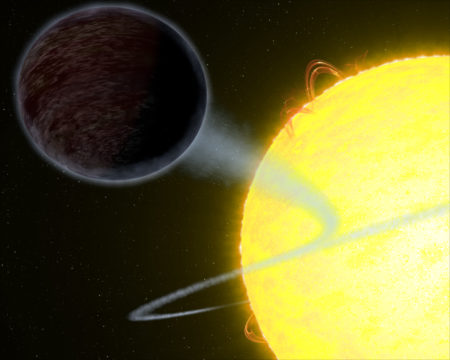Researchers have found that a football-shaped, ultra-hot gas giant that’s being devoured by its host star is also one of the least reflective exoplanets ever found.

NASA, ESA, and G. Bacon (STScI)
Imagine a football-shaped planet covered in a fresh layer of asphalt and you might get close to what WASP-12b, a hot Jupiter 900 light-years away, would look like to a hypothetical space traveler. Add a faint red glow like that of a smoldering iron and you’re probably dead on.
A group of astronomers led by Taylor Bell (McGill Space Institute) helped paint that picture. They discovered that WASP-12b is one of the least reflective exoplanets known to date. Bell’s team used the Hubble Space Telescope to observe the planet as it passed behind its host star, measuring the tiny dip in light due to the disappearance of the planet’s reflection of starlight. They found that it absorbs 94% of the visible light it receives, compared to 60% for most hot Jupiters.
WASP-12b is a gaseous giant orbiting a Sun-like star once a day, close enough to be roasted by stellar radiation. The planet has taken the shape of a football due to strong tidal forces. The same forces cause the planet to always face the same side to its star, which makes the dayside temperature rise to a toasting 3100°C. The extreme heat not only prevents the formation of clouds, which could reflect some light back to space, but it also dissociates hydrogen molecules (H2) into hydrogen atoms (H), which absorb even more light.
This is only the second time researchers have used this method to spectrally resolve reflected light from a hot Jupiter. On exoplanet, HD 189733b, Hubble revealed a very different world, one where silicate beads in the atmosphere scatter blue light.
Another hot Jupiter called TrES-2b actually holds the record for the darkest exoplanet — it’s so light-hungry that it absorbs more than 99% of its star’s light.
But none of that makes WASP-12b any less fascinating — it’s a strange world that has found itself the subject of many investigations.
Puffed-Up World
Since it was discovered in 2008, WASP-12b has been observed at many wavelengths, including with NASA’s Great Observatories: Hubble (visible/UV), Spitzer (infrared), and Chandra (X-ray). Hubble’s Cosmic Origins Spectrograph revealed in 2010 that the planet is slowly being devoured by its host star. They’re so close together that the star is pulling gas away from the planet. At the current rate of dissolution, scientists estimate that in roughly 10 million years WASP-12b will be no more.
The weird planet also appears to be bloated: even though it only has 1.4 Jupiter’s mass, it’s three times Jupiter’s size. Some researchers think that electric currents emanating from the star could link to the planet’s magnetic field, ionizing particles to puff up the atmosphere.
Probing WASP-12b’s Atmospheric Chemistry
Previous observations using transmission spectroscopy, which probes a sliver of atmosphere at the boundary between night and day, have showed hints of a titanium oxide haze — a powerful heat absorber. But it can’t contribute to the low reflectivity that Bell’s team found. “Our observations firmly reject such a model for the planet's dayside, which is not overly surprising as we would expect the dayside would be far too hot for this haze to exist,” Bell says.
But with a difference of 1000°C between the planet’s nightside and dayside, each side might exhibit completely different chemistries. “It’s entirely possible,” Bell adds, “that such haze may form closer to the night side of the planet and affect the transit observations.”
WASP-12b will probably continue to surprise us: The planet will almost certainly be observed with the James Webb Space Telescope, scheduled for launch in 2018. Those observations could give additional insights into the strange properties of WASP-12b’s atmosphere.
References: Bell et al. “The Very Low Albedo of WASP-12b from Spectral Eclipse Observations with Hubble.” Astrophysical Journal Letters, September 14, 2017.
 0
0









Comments
You must be logged in to post a comment.